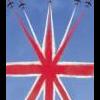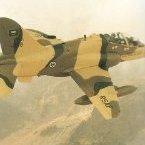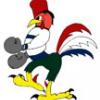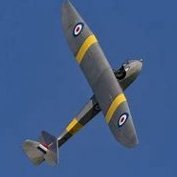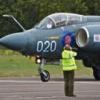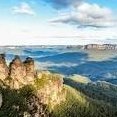-
Posts
780 -
Joined
-
Last visited
Profile Information
-
Gender
Male
-
Location
South Wales
Recent Profile Visitors
3,613 profile views
StephenMG's Achievements

Obsessed Member (4/9)
544
Reputation
-
The coating covers the splitter plates completely and extends right down to the compressor face - the whole intake trunking is covered. I did have a good photo but can't lay a hand on it at the moment. However, there are some decent ones of Yeovilton's T.8M in the walkaround section here,
-
The intakes weren't painted, they were covered in a protective rubber coating which extended around the intake lips and over the boundary-layer splitter. It's an off-white/ivory colour.
-
.thumb.jpg.664066d6dc0dd0d08b6eadb937de4cad.jpg)
RAF Tangmere - Hunter F.5, 34 Sqn, 1956.
StephenMG replied to Lord Riot's topic in Work in Progress - Aircraft
Calm down. That's a very well known and well published Air Ministry photograph so the eBay vendor will have no rights over it anyway.- 34 replies
-
- 3
-

-

-
You're very welcome. Shame I can't find a clear photo though. This might help a bit as it's side on and shows the general size quite well,
-
@StuH@XV571 Found it - this is from the FGA.78 Vol.1 and shows both packs - note also the strap and buckle passing around the control tube casing, I hope that helps. I'll see if I can find a clear photo but I can't remember seeing one in all honesty - it's a tricky location. 👍
-
@StuH@XV571 That tan bag behind the headbox is "Survival Pack A". There was a second smaller one, predictably called "Survival Pack B" 😁 strapped to the staboard cockpit wall adjacent to the pilot's shoulder. Pack A is like a asymmetrical horseshoe shaped thing that sits over the top of the control tube casing. I'll see if I can find a picture - I'm pretty sure there's a line drawing in one of the manuals. Bear with me...
-
Right, that's it. No more tinkering with this, I'm calling it done! Now with added chocks, parachute, label and dog ball! 😁
-
The base is an MDF disc. Onto that I glued a piece of the stuff you buy in garden centres to line hanging baskets. I weighted it down and left it a good while to make sure it was well stuck then ripped most of it off leaving a stuck layer with random grassy looking fibres. That layer I then further trimmed right down to scale length with a scissors. I was tempted to leave it like that but it wasn't quite green enough and I thought needed some more texture - you can just about see the original effect around the very edges of the base. So I heavily sprayed it with 'extra firm hold' hairspray and gradually sprinkled on some Woodland Scenics grass scatter. When it looked about right and the hairspray had dried I gave it another heavy coat of hairspray to hold it all together. The little clumps of dandelions (or buttercups, I'll leave you to decide! 😁) are just small bits of model railway lichen/bushes with the ends picked out with yellow paint. Hope that helps, Mark
-
It's probably 3 years since I last made a model so I suppose this is a mini-return to the hobby! The background to this is that my dad was stationed with 233 OCU at RAF Pembrey during his time in the RAF in the 1950s. I had a plan to make models of the aircraft operated by the OCU but that plan expanded a bit to include other aircraft operated from Pembrey. Progress stalled somewhat, then my dad sadly passed away earlier this year and, in an attempt to distract myself, I resumed work on this which I started way back in September last year. 316 Squadron was the last of the Polish squadrons created in Britain during WWII and become operational at Pembrey on 15th February1941 with the Hurricane Mk.I. After a bit of research, P3100 caught my attention. On 26th May 1941 it was being flown by Sgt. Pawel Piotr Gallus. On take-off it seems he was a bit keen retracting the undercarriage resulting in the prop striking the ground and shortening the blades by 4 inches. Sgt. Gallus failed to notice and went on to conduct his planned 90 minute sortie over the sea, only discovering what had happened after landing back at Pembrey! Despite a further hair-raising incident (after transferring to 7 Squadron at Colerne for night-flying training on a training flight he collided with another Hurricane in the pitch dark when the light in a Turbinlite Havoc failed to ignite, both Hurricane pilots bailed out) I'm pleased to say Gallus survived the war (by then a Warrant Officer), got married and lived in Northampton until his death on 19th April 2011. Anyway, this is my model of P3100. It's the lovely new(ish) Airfix 1/48 Mk.I. I'm sure you've seen the ICM figures a million times before but I found a photo of a 316 Squadron Hurricane with a couple of 316 Squadron personnel - one wearing a peaked cap and another with an Irvin flying jacket, so they seemed appropriate! I couldn't find a 1/48 trolley acc so had to scratch build this one. It's not 100% accurate but I'm happy enough with it. And, as a tribute to the man himself, Sgt. Pawel Piotr Gallus, All the best, Mark UPDATE- finished fettling this at last. Added chocks, parachute and dog's ball!
- 16 replies
-
- 62
-

-

-
.thumb.jpg.664066d6dc0dd0d08b6eadb937de4cad.jpg)
Airfix 1:48 Hawker Hunter F.1 Conversion
StephenMG replied to Warwolf's topic in Work in Progress - Aircraft
The early ones were red too rather than the later black/yellow stripes. -
.thumb.jpg.664066d6dc0dd0d08b6eadb937de4cad.jpg)
Ejection Seats for Hawker Hunter F.4 and F.6
StephenMG replied to Brad-M's topic in Aircraft Cold War
The Mk.3H seat started to be fitted with the F.6A and FGA.9 so for an F.4 or F.6 stick with the 2H. The two seats were similar but the 3H's seat pan lacked thigh guards. Later on, the RAF started fitting the 2H to FGA.9s again for some reason - possibly because the thigh guards were actually a good idea?! -
.thumb.jpg.664066d6dc0dd0d08b6eadb937de4cad.jpg)
Airfix Vulcan. Talk about falling at the first hurdle!
StephenMG replied to Graham T's topic in Aircraft Cold War
This exactly hits the nail on the head. They've become good at producing kits of specific airframes rather than the type as a whole. The first kit that fell into this category for me was the 1/48 Hunter F.6. For example, the airframe they scanned had no blast deflectors so there were no blast deflectors in the kit, despite them being a very well known characteristic of the F.6. There were strange raised panels on the wings which never existed on the real aircraft yet, presumably because of some anomaly in the LIDAR process, these panels apeared in the scan (and hence in the kit) as raised 'plates'. And don't get me started on the nose gear. A 5 second glance at a real Hunter would have fixed all these things. The Mosquito, as others have already mentioned, is a classic example - it's a model of the specific airframe they scanned with, apparently, no additional research gone into the kit design. They seem to be relying almost entirely on the LIDAR results these days which, to my mind, should be used for overall shape and dimensions only and the details arrived at by proper research. On the bright side, I suppose we do now have models that are the right general shape and size, and it gives aftermarket manufacturers an opportunity to fix the details! 😁 -
.thumb.jpg.664066d6dc0dd0d08b6eadb937de4cad.jpg)
Aftermarket Martin-Baker seat identification - help wanted.
StephenMG replied to Welkin's topic in Aircraft Cold War
As is often the case it's vague/inaccurate enough to represent any number of seats! Definitely looks like a MB Mk.3 of some sort though. Could be used as a 3H for a late Hunter or a 3B for a Vampire T.11 of a 3J for a Javelin for example. -
.thumb.jpg.664066d6dc0dd0d08b6eadb937de4cad.jpg)
1/72 Hawker Tempest Mk. V by Airfix - release Autumn 2021
StephenMG replied to Bjorn's topic in The Rumourmonger
An excellent choice T-21! Thats' exactly what I did with my Heller one (although I never did get around to finishing the base!) - my father was an airframe fitter on Hunters at Pembrey 1956-57. I also did some profile artwork for a D&V Tempest book a few years ago and made sure to inlcude a 233 OCU TT.5 in that too!- 350 replies
-
- 17
-

-
.thumb.jpg.664066d6dc0dd0d08b6eadb937de4cad.jpg)
Hawker Hunter Underbellies , What Do You Use?
StephenMG replied to MatthewAV8B's topic in Aircraft Cold War
A couple of years I did the artwork for the Pen & Sword FlightCraft Hawker Hunter book. One of the subjects I was keen to draw was one of the 'PRU Blue' Hunters from RAFG but I'd also heard there was some dispute over their existence. There is anecdotal evidence from personnel that were there at the time that at least one Hunter was spotted with blue undersides. There is also a black and white photo of F.4 WT748 taken at Bruggen which appears to show blue undersides, albeit with the usual problems of interpreting colour from a monochrome photo. However, it does show very little contrast between the Dark Sea Grey of the camo and the underside colour - very similar to the level of contrast seen in photos of RAFG Swifts and much less than you normally see with Hunters. Handily I found a photo of a Swift and Hunter in flight together. That was useful in confirming the contrast between the under- and upper-side colours of the Swift (which matched the photo of WT748) and also showed the significantly higher contrast between the upper- and under-sides of the Hunter which had its usual High Speed Silver finish. The killer evidence for me though, and what convinced me that WT748 was indeed finished in PRU Blue, was found by closer examination of the Bruggen photo. Firstly, the main gear leg of a second Hunter was visible under the belly of WT748. This was crucial as it showed a second aircraft under exactly the same lighting conditions. The colour on those gear doors was very much lighter than WT748 and exactly what you'd expect to see for High Speed Silver. The difference was such that it can only be due to differing paint colours, especially as the lighting conditions were identical for both. Secondly, as was normal with Hunters, the gun pack had clearly been changed and a pack in the usual High Speed Silver had been fitted. This showed a very much lighter colour than the rest of the undersides. Also, it appeared that the radio bay doors had been replaced - they too showing the same difference in colour. Thirdly, the starboard link collector (forward section) although matching the 'blue' of the undersides had very clear scuff marks on it, as you'd get when the collector was removed and placed outside-down on the tarmac. That scuffing allowed a very much lighter colour (aluminium) to show through. Whether any other Hunters were finished in PRU Blue is anyone's guess (it doesn't help that 118 was such a short-lived squadron) but I'm now sure that WT748 was and so I based my profile for the book on that Bruggen photo. (Sorry for the novel!)


